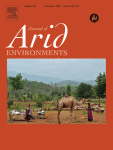Ver ítem
- xmlui.general.dspace_homeCentros Regionales y EEAsCentro Regional Patagonia SurEEA EsquelArtículos científicosxmlui.ArtifactBrowser.ItemViewer.trail
- Inicio
- Centros Regionales y EEAs
- Centro Regional Patagonia Sur
- EEA Esquel
- Artículos científicos
- Ver ítem
Grass recruitment constraints along a grazing gradient in Patagonia: N-limitation x adult competition trade-off
Resumen
We explored the effect of N addition and adult canopy competition on the recruitment of lost preferred species in the Patagonian steppe, where a decelerated N cycling scenario (sensu Ritchie et al., 1998) had been previously detected. In the first experiment we demonstrated that the preferred scarce grass Bromus pictus has typical traits of Competitive species, while the dominant less preferred Pappostipa speciosa has typical traits of Stress tolerant
[ver mas...]
We explored the effect of N addition and adult canopy competition on the recruitment of lost preferred species in the Patagonian steppe, where a decelerated N cycling scenario (sensu Ritchie et al., 1998) had been previously detected. In the first experiment we demonstrated that the preferred scarce grass Bromus pictus has typical traits of Competitive species, while the dominant less preferred Pappostipa speciosa has typical traits of Stress tolerant species (sensu Grime, 1997): B. pictus showed higher maximum Relative Growth Rate, water consumption and competitive ability than P. speciosa. In the second experiment, we proved that without N addition, seedlings of the preferred species showed its maximum survival rate under moderate grazing, where adult competition is lower than under ungrazed conditions and N-limitation is lower than under intense grazing. Instead, with N addition, the survival rate of B. pictus was maximum under intense grazing, where N limitation is maximum and adult competition is minimum. These results suggest that in degraded systems subjected to a decelerating N cycling scenario, the revegetation with preferred species would require recovering soil N levels, and would be more successful in the most degraded sites, where the remnant canopy has low cover.
[Cerrar]

Autor
Garcia Martinez, Guillermo Carlos;
Golluscio, Rodolfo Angel;
Fuente
Journal of Arid Environments 189 : 104480 (2021)
Fecha
2021-03-09
Editorial
Elsevier
ISSN
0140-1963
Formato
pdf
Tipo de documento
artículo
Palabras Claves
Derechos de acceso
Restringido
 Excepto donde se diga explicitamente, este item se publica bajo la siguiente descripción: Creative Commons Attribution-NonCommercial-ShareAlike 2.5 Unported (CC BY-NC-SA 2.5)
Excepto donde se diga explicitamente, este item se publica bajo la siguiente descripción: Creative Commons Attribution-NonCommercial-ShareAlike 2.5 Unported (CC BY-NC-SA 2.5)

